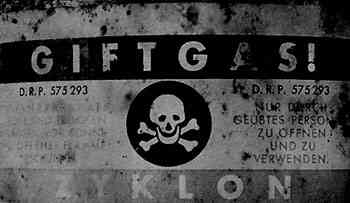Gassing Victims in the Holocaust: Zyklon-B
Zyklon B was used in Germany before and during the Second World War for disinfection and pest extermination in ships, buildings and machinery. In the Auschwitz concentration camp as well, it was used exclusively for sanitation and pest control until the summer of 1941. After the end of August 1941, Zyklon was used in the camp, first experimentally and then routinely, as an agent of mass annihilation. Zyklon B consisted of diatomite, in the form of granules the size of fine peas, saturated with prussic acid. In view of its volatility and the associated risk of accidental poisoning, it was supplied to the camp in sealed metal canisters.
The Zyklon used at Auschwitz concentration camp was produced by a firm called Degesch (Deutsche Gesellschaft für Schädlingsbekämpfung mbH), with headquarters in Frankfurt am Main and forming a part of IG Farbenidustrie AG.
The following is a scientific breakdown of Zyklon-B:
Hydrogen cyanide HCN, prussic acid, is a chemical compound in the form of a powerfully poisonous, volatile colorless liquid with the odor of bitter almonds. Prussic acid is considered a battlefield poison agent. Its action depends on the restraint of cellular respiration as a result of neutralizing the respiratory enzymes. Prussic acid passes through the mucous membranes and the skin, but principally through the lungs, into the blood. It blocks the process by which oxygen is released from red blood corpuscles and the result is a sort of internal asphyxiation. This is accompanied by symptoms of injury to the respiratory system, combined with a feeling of fear, dizziness and vomiting.
Sources: The Institut Fuer Zeitgeschicthe (Institute for Contemporary History) in Munich, Germany, 1992.



